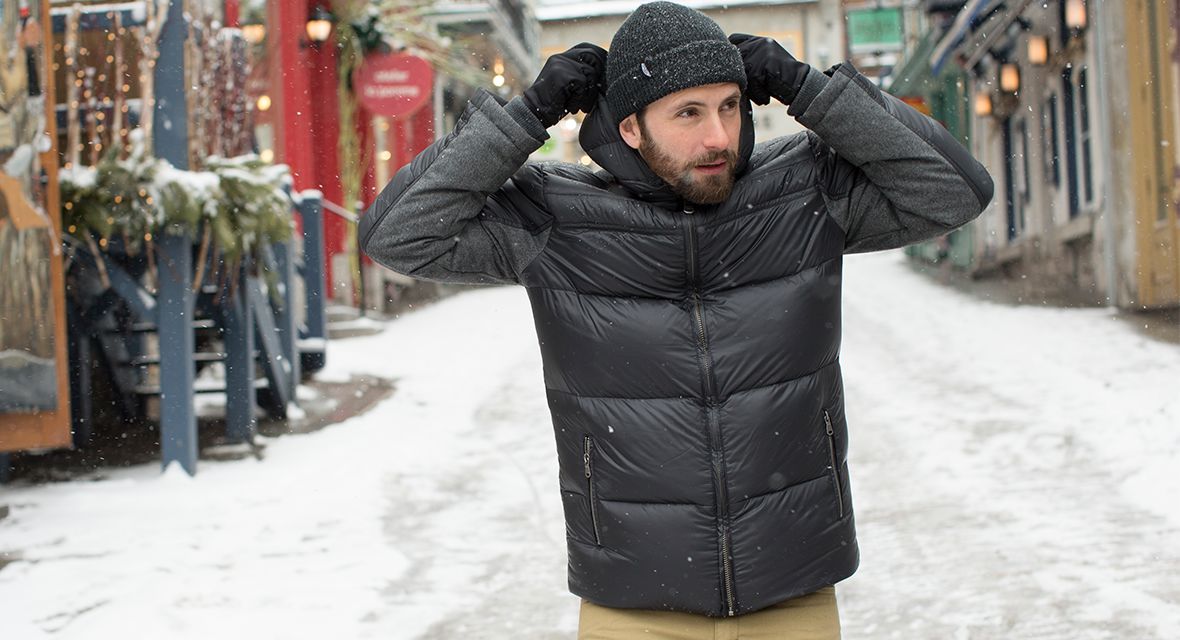
Insulated Clothing Guide
To deal with the winter weather, we do not always want to bundle up like the Michelin man. The alternative? Insulated, warmer, thinner clothing that moves with you. So here are some tips for choosing a parka, jacket or anorak… to protect yourself adequately against the bitter cold.
BUYING
In general, insulated clothing is worn under two types of circumstances: in urban settings and when doing activities that only require a small expenditure of energy (such as downhill skiing) and/or that take place in an especially cold environment (such as winter camping). In either case, you have to look at three aspects:
- comfort rating, i.e., the ability of a piece of clothing to resist different temperatures;
- the recommended insulation (synthetic or down);
- construction of the clothing.
Comfort rating
The comfort rating corresponds to the lowest temperatures against which clothing can protect. To accurately determine this rating, you must think of all possible scenarios for using it over a given year, and evaluate which comfort rating best corresponds to your reality.
Although you can generally rely on the temperatures (-15°C, -25°C, -40°C, etc.) specified by the manufacturer, you should also consider your metabolism, your diet and your tolerance to the cold , among other variables that will influence your final choice of clothing. Thus, a person who is sensitive to the cold would be better off choosing a warmer piece of clothing, even if he does not plan to use it in low-temperature conditions.
Insulation
The quality of an insulation material is determined by its ability to retain air, which is not a good heat conductor. The more insulation can easily trap air, the more clothing will remain comfortable in lower temperatures.
Although many synthetic insulations have become increasingly effective, down remains the best insulation around: in fact, there is nothing warmer or more comfortable for a piece of clothing.This is generally best in an urban setting.
There are many different qualities of down. Thus, thick, down-insulated clothing are not necessarily warmer than similar, but thinner clothing: it all depends on the quality of the down feathers. In general, the more the shaft of the feather is thin and supple, the more insulation that down will have. In addition, although duck down provides excellent insulation, geese down is known to be of better quality.
However, down does have a downside:
- when wet or soaked, it loses its ability to trap heat;
- it takes a long time to dry;
- it is not recommended for people with allergies;
- it is more expensive.
Synthetic insulation is heavier, not as compressible and does not last as long as down, but is not as expensive. However, synthetic insulation does not absorb water as much, thus maintaining its heat index easier and drying quicker. As a result, it is less prone to mildew, and is often appropriate for activities that produce body humidity.
Shape
Once insulation has been selected, you must look at the exterior shell. The shell has three functions:
- to keep insulation in place;
- to serve as a wind screen;
- to allow internal transpiration to escape.
More often than not, the shell is made of a ripstop nylon (which prevents tears from becoming larger) or taffeta. Nylon is light and therefore must be tightly woven to prevent the insulation from accumulating in a corner of the clothing, as well as to minimize wind infiltration.
The inner lining must be able to breathe and easily evacuate humidity. Therefore, it is not recommended to use cotton or poly-cotton, which becomes soaked easily.
To prevent cold from entering through the seams, insulation layers must ideally overlap and not be sewed edge to edge. For down, it is sometimes recommended to create small stitched boxes, which are sewn in the shell lining to stop the down from settling in one spot and to prevent cold air from entering.
Zippers should be cable stitched and made of nylon, which is lighter, easier to handle and less likely to get stuck, unlike "teethed" zippers.
USE
Ideally, the clothing must be worn close to the body to minimize the quantity of interior air to be warmed up. If there are lower drawcords, they must be adjusted to prevent warm air from escaping through the bottom.
Since we lose up to 80% of our heat through our head, having a hood on the clothing is generally appropriate, even if it is removable. In very cold weather, the hood will help keep heat inside; when the outside heats up, you can remove it to allow excess heat to be released.
Wearing a scarf is recommended at all times to act as a "heat plug" in the upper part of the clothing. Once again, you can simply untie the scarf if you suddenly warm up.
Before putting away insulated clothing, it is recommended that it be shaken and aired until it is completely dry.
It is best to put away the clothing by hanging it in a dry place away from the sun.
To wash insulated clothing, use a gentle liquid soap for synthetic insulation and a special soap for down insulation.
Wash the clothing in a bathtub or a front-loading washer set on the delicate cycle. Do up the zipper and connect the velcros before proceeding.
In the bathtub, soak the clothing, soap it up with detergent and rinse it several times until the water becomes clear. Towel-dry the clothing to remove as much water as possible, but never wring it. To remove the clothing from the bathtub, take the entire piece of clothing and spread it out to its full length in order not to damage the inside of the clothing.
Dry the clothing as soon as possible (especially if it is down) in a tumble dryer on cold or warm air. Put a few tennis balls in the dryer to accelerate drying, to help the clothing regain its volume and evenly spread out the insulation inside.









